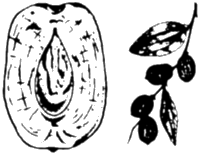 |
 |
 |
 |
| APPENDIX B |

Description: The common jujube is either a deciduous tree growing to a height of 12 meters or a large shrub, depending upon where it grows and how much water is available for growth. Its branches are usually spiny. Its reddish-brown to yellowish-green fruit is oblong to ovoid, 3 centimeters or less in diameter, smooth, and sweet in flavor, but has rather dry pulp around a comparatively large stone. Its flowers are green.
Habitat and Distribution: The jujube is found in forested areas of temperate regions and in desert scrub and waste areas worldwide. It is common in many of the tropical and subtropical areas of the Old World. In Africa, it is found mainly bordering the Mediterranean. In Asia, it is especially common in the drier parts of India and China. The jujube is also found throughout the East Indies. It can be found bordering some desert areas.
Edible Parts: The pulp, crushed in water, makes a refreshing beverage. If time permits, you can dry the ripe fruit in the sun like dates. Its fruits are high in vitamins A and C.


Description: This plant has tiny leaves arranged alternately. Its stem creeps along the ground. Its fruits are red berries.
Habitat and Distribution: It only grows in open, sunny, wet areas in the colder regions of the Northern Hemisphere.
Edible Parts: The berries are very tart when eaten raw. Cook in a small amount of water and add sugar, if available, to make a jelly.
Other Uses: Cranberries may act as a diuretic. They are useful for treating urinary tract infections.
| Updated: 26 February 2011 |
|
Born on 02 January 1999 |